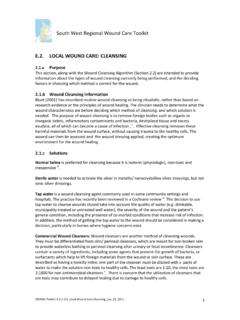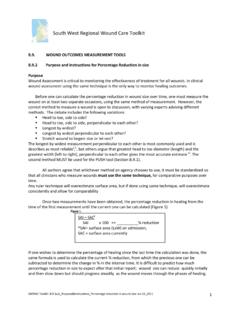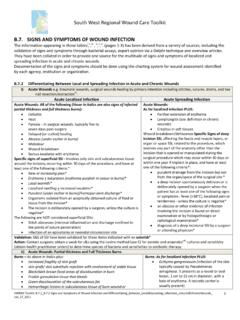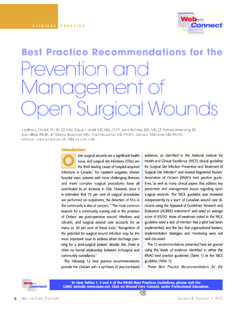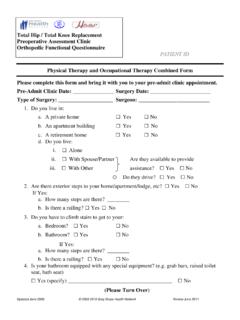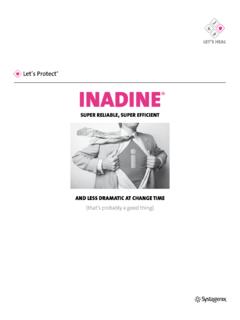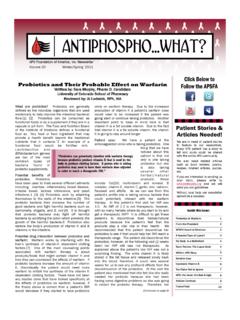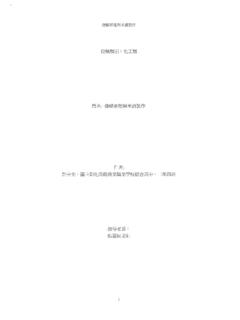Transcription of INADINE - southwesthealthline.ca
1 INADINE . SUPER RELIABLE, SUPER EFFICIENT.. AND LESS DRAMATIC AT CHANGE TIME. (that's probably a good thing). INADINE . What is it? INADINE PVP-I Non-Adherent Dressing consists of a low adherent knitted viscose fabric impregnated with a polyethylene glycol (PEG) base containing 10% Povidone Iodine; equivalent to available iodine. The Povidone molecule provides an effective release of iodine. The polyethylene glycol provides a water-soluble environment, which allows the Iodine to reach the bacteria in the wound.
2 What does it do? INADINE dressings are designed to protect the wound from infection 1-3. When do I use it? INADINE is indicated for the management of ulcerative wounds and may also be used for the prevention of infection in minor burns and minor traumatic skin loss injuries. How do I use it? Preparation Prepare the wound in accordance with standard wound management protocol. Application Apply directly to the wound or burn site. To ensure INADINE dressing stays in situ, use with a secondary dressing like TIELLE Hydropolymer dressing.
3 Changing the dressing When the colour of the dressing turns to white, this indicates the loss of antiseptic efficacy and this is when the INADINE dressing should be changed. INADINE may be changed up to two times daily in the initial phase. With heavily infected wounds, it may also be used in conjunction with systemic antibiotics. Should there be any difficulty when changing the dressing, removal may be helped by gentle stretching of the dressing at diagonally opposite corners. Please refer to the package insert for full instruction LET'S TALK.
4 To learn more about the benefits of INADINE Povidone Iodine Non-Adherent dressing, contact your Systagenix representative at 1-877-216-0187 or visit CODE SIZE EACHES PER. CARTON. P01481 5cm x 5cm 25. P01512 x 25. SYS/CAN/483/0411. References 1. McLure et al. Journal of Hospital Infection. 1992 Aug; 21(4):291-9. 2. Goldenheim Postgrad. Med. Jnl., 1993; 69 (suppl. 3): S97-S105. 3. Langley. INADINE * wound dressings speed healing, reduce patient discomfort and cuts costs by almost 40%. Burns 1989 Systagenix Wound Management 2011.
5 Brands marked with or are trademarks of Systagenix. All other products referenced herein are acknowledged to be trademarks of their respective owners. First choice, safe choice for infected wounds For a wide range of infected wounds INADINE * dressing may be used for acute superficial wounds, even if infected, and for the prevention of infection in minor burns, minor traumatic skin loss injuries and as part of the treatment for ulcerative wounds, such as: Prophylaxis in minor trauma Dressing of cuts, grazes, fingertip injuries and bites Chronic wounds such as leg Post-operative prophylaxis ulcers and pressure sores INADINE * dressings provide a long lasting antiseptic effect, which manages infection by bacterial, protozoal and fungal organisms over a period of time.
6 Contra-indications: INADINE * dressing should not be used l where there is a known iodine hypersensitivity (allergy). l before and after the use of radio-iodine (until permanent healing). l if you are being treated for kidney problems l in pregnant and breast feeding women l in cases of Duhring s herpetiform dermatitis (a specific, rare skin disease). INADINE * dressing must be used under medical supervision l in patients with any thyroid diseases l in newborn babies and infants to the age of 6 months as povidone iodine may be absorbed through unbroken skin l to treat deep ulcerative wounds, burns or large injuries.
7 How to use INADINE * dressing The dressing is for topical use only. It is suitable for use in adults and children over 6 months. Preparation Prepare the wound according to wound management protocol. Ensure skin surrounding the wound is dry. Remove the INADINE * dressing from the packaging with sterile foreceps. Application Remove one backing paper, peel off the dressing from the remaining backing paper and apply it directly to the wound. The knitted construction of INADINE * dressing significantly reduces the level of contact with the wound.
8 Cover and secure with a secondary dressing of choice. Changing Fading of the colour of the dressing indicates the loss of antiseptic efficacy and the INADINE * dressing should be changed. It may be changed up to two times daily in the initial phase. With heavily infected wounds, it may also be used in conjunction with systemic antibiotics. Should there be any difficulty when changing the dressing, removal may be helped by gentle stretching of the dressing at diagonally opposite corners. Techniques for using INADINE * dressing Application to a finger Make four incisions Remove the two Wrap the dressing around the digit as shown.
9 In some backing papers starting with the bottom flaps, then cases two incisions and place the fold the dressing over the tip, smooth in the middle of the dressing on the the middle flaps along the sides and dressing might digit as shown. wrap the last flaps as shown. Cover be sufficient. with an appropriate secondary dressing. Application into a cavity Cut the dressing into Remove the two backing papers and fill the cavity as a spiral as shown. shown. Cover with an appropriate secondary dressing. How INADINE * dressing works INADINE * dressing is a topical wound dressing impregnated with an ointment containing 10%.
10 Povidone iodine (PVP-I). The dressing also contains polyethylene glycol and purified water as inactive ingredients. The povidone molecule provides a sustained release of iodine. The polyethylene glycol provides a water-soluble environment, which allows the iodine to reach the bacteria in the wound. Mode of action Broadest spectrum antiseptic Gram-ve Gram+ve Anaerobes Yeast Fungi Spores Bacteria Bacteria Povidone Iodine Framycetin Sodium Fusidate Chlorhexidine The povidone iodine in INADINE * dressing is the broadest spectrum antiseptic for human use and has no reported cases of acquired ,2.
